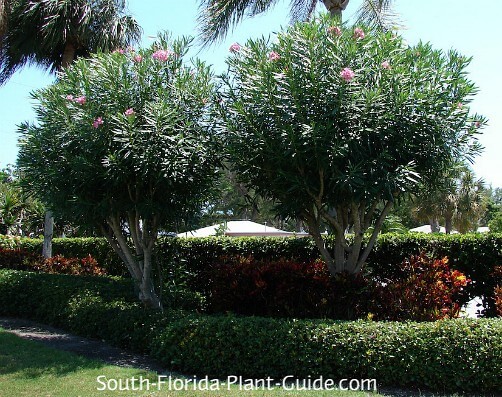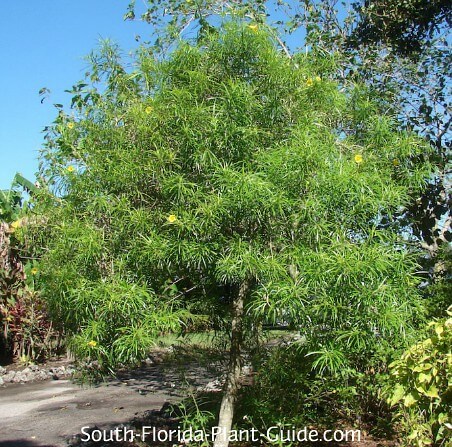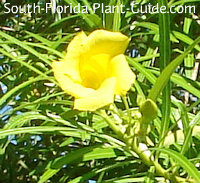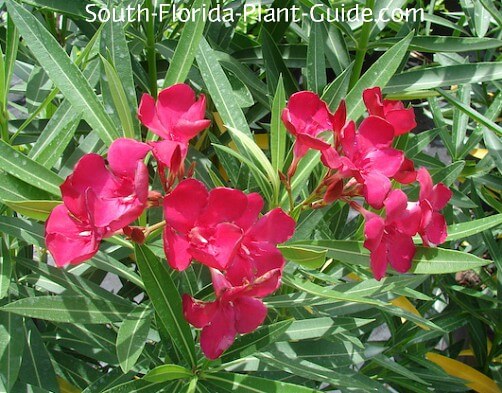Oleander Tree
Nerium oleander
The hardy and beautiful oleander tree thrives in a sunny spot anywhere in South Florida.

This ornamental flowering tree starts life as an oleander shrub, which can be left to grow large with a trimmed-up base as it becomes a multi-trunk tree. Or you can buy one trained to a single trunk for a more classic tree-like appearance.
Bright, showy flowers in shades of white, pink and red are most common, appearing on and off all year, more in warmer months.
Oleanders don't take a lot of care - other than regular maintenance and a good spring pruning - if they're planted in the right location.
They make a good choice as an easy-care tree for a small yard or as an accent for larger landscapes.
Unfortunately, the oleander plant has developed a reputation as a plant to avoid for two reasons:
- The plant is TOXIC if ingested - as are quite a few common South Florida landscape plants, including crotons.
- Oleanders attract particularly nasty
caterpillars that can defoliate it in no time flat.
The toxins most commonly cause skin irritations from trimming and handling cuttings.
Not everyone is affected by this, but wearing good garden gloves and protective eyewear should keep you from having any adverse effects, even if you have sensitive skin.
Avoid planting where young children, pets or livestock would come in contact. If there's a
chance a child or animal will ingest leaves, stems or any part of an
oleander, oleander poisoning is no small matter. Always place it in an
area where this scenario can't occur.
You can outsmart the nerium
caterpillars by placing the tree far enough away from any structure so
that the caterpillars have nowhere nearby to cocoon.
That's their M.O. - eat, then cocoon. The more convenient the cocooning spot, the more likely it is that they'll feed on your oleander.
Yellow oleander tree

Sometimes called "Lucky Nut" (but don't eat the nuts!), this plant can be grown as a small tree of about 12 to 15 feet.
It's a cousin of nerium oleander, and blooms throughout warm months. Botanical name is Cascabela thevetia - previously thevetia peruviana.

Plant specs
An oleander tree is a fast grower that can reach as much as 15 feet tall. It's best kept fat and bushy around 6 to 8 feet tall, with a wide crown.
These plants are cold hardy - fine anywhere in South Florida including all of Zone 9. They are moderately salt-tolerant and moderately drought-tolerant once established.
The oleander is evergreen and blooms on and off all year, with heaviest flowering during warmer months. It's also considered deer-resistant.
Plant care
Plant in full to partial sun in an area that drains well.
Add top soil to the hole when you plant - and adding composted cow manure as well will get your oleander tree off to a great start.
Do a heavy pruning in spring (late March to early April) to encourage strong stems and bushy growth. Snip off new shoots around the base occasionally to keep the look of a tree.
If caterpillars attack your oleander, spray with thuracide, a natural bacterial product. Even if most of the leaves have been munched off, trim the tree back and it should flush out again.
Regular watering is best, though oleander trees prefer to dry out between waterings.
Fertilize three times a year - once each in spring, summer and autumn - with a quality granular fertilizer. You can supplement feedings with bone meal to promote heavier bloom.

Plant spacing
Plant well away from structures to discourage caterpillars, preferably 10 to 12 feet or more from the house, fence, or anything else where caterpillars can cocoon.
If you're planting several trees, they can go as close as 6 feet apart, or, for a more formal look, place them 10 to 12 feet apart.
Oleander trees will grow in large containers while young but at some point you'll need to transfer the tree to a place in the yard.
Landscape uses for oleander tree
- anchor for a garden bed
- single yard specimen
- lining the side of a driveway
- in pairs flanking the open entrance (with no fence) to a drive or walkway
GOOD SNOWBIRD PLANT? MAYBE (oleanders flower less in winter)
COMPANION PLANT SUGGESTIONS: Plant with other easy-care sun lovers that won't get tall enough to hide the tree's trunk: carissa, blueberry flax lily, dwarf ixora, African iris, variegated arboricola, lantana, sweet potato vine, and beach sunflower.
Other plants you might like: Jatropha Tree, Red Cluster Bottlebrush Tree
Take a break!
The ultimate guide to low-maintenance plants
and landscaping!
An ebook by
Chase Landre
author of
South-Florida-Plant-Guide.com
Learn more!
Get a greener thumb!
Want to learn more about South Florida planting, watering, fertilizing and dealing with weeds and pests?
See our Gardening How-To section for answers!
Get instant curb appeal!
An ebook by
Chase Landre
author of
South-Florida-Plant-Guide.com
Learn how to get instant curb appeal with fast growing plants and landscaping techniques!


